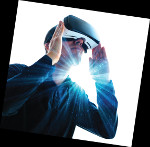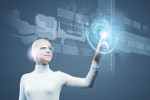The HoloLens device is the latest invention from Microsoft – a piece of equipment that allows users to see through walls and have microscopic vision. Chief Executive Officer meets Ben Reed, director of HoloLens business strategy, and the Windows and Devices Group at Microsoft, to find out about the device’s potential, as it blurs the lines between the virtual and physical worlds.
Every CEO could do with superhuman powers. But while nothing beats face-to-face interaction when meeting with business partners, but the modern chief executive is expected to travel vast distances to meet with clients and business partners. If only there was a way to combine the convenience of a skype meeting with the benefits of human interaction – well now, Microsoft’s HoloLens is making the impossible, possible.
Exciting new technology
Optically, the main difference between a hologram and a real object is that instead of being made of physical matter, a hologram is made entirely of light. Effective 3D imaging is now available on many smartphones, but Microsoft’s HoloLens takes the technology to new levels by using holographic imaging to combine virtual elements with real-world imaging.
The Microsoft HoloLens enables users to have microscopic vision, so they can see a view that's tiny, which is blown up to a larger size. If the user wants to look at the molecular structure of a cell, they are able to do that holographically. This device allows wearers to view a hologram as if it existed in the real world; HoloLens constantly analyses the environment, scanning to understand where the floor, walls and ceiling are. The technology is also not bound by the laws of physics, explains Ben Reed, director of HoloLens business strategy, and the Windows and Devices Group at Microsoft.
“Let's say I wanted to see what the solar system looked like; if I have a digital model of that, I can make it appear to exist as though it were right in front of me,” he says. “Another [use] is X-ray vision. Now, it doesn't actually create any X-rays, but imagine a service technician who has come to service a room, and the [plans] that were created when that building was built show the service lines, and all of the other things, that are in the wall that the technician can't see. Because HoloLens has the ability to overlay that digital information at the size and scale of the real world, it would essentially give the user the power to see through the wall and to see where those service corridors were, or the lines that they need to service in order to do their job. It's software, so the only limits with software are one’s imagination and time.”
Spatial sound
Spatial sound is another feature, which enables users to give sound a three-dimensional location in a physical space. Take when a door slams behind someone, they know where the source of the sound is coming from, even though they are not looking at it. This is because of the way that the brain works and its connection to the ears. One would know where the sound came from and the brain would make a decision as to whether they need to look around in that direction.
“We can use that same capability human beings have to do some really useful things,” Reed enthuses. “Spatial sound is cool, but it's not because it's cool that we use it; it's because it's useful. In a factory floor setting, for example, imagine a technician is working with HoloLens and there's a hazard over their right shoulder, and someone needs to alert them to that hazard. They can use spatial sound to direct them in that way.”
How it works
The device’s complex collection of sensors does all of this work, and it also looks down at the wearer's hands. Reed explains that this is an especially useful ability for first-line workers who operate machinery or tools, especially if they have things on their hands, like gloves or other equipment, and they do not want to have to keep taking the glove off to reach for a mouse or other input devices.
“It's not just about gestures,” Reed states. “There's a whole variety of different ways you can interact with HoloLens because it is a Windows 10 computer. In the same way that users can plug millions of different USB devices [into the new Surface computer], the options for input are pretty vast. We've got a lot of signal and plenty of information back from [people who have used the device to solve real-world problems] in terms of how HoloLens can be used – not just because it's cool new technology, but because it's providing differentiated, measurable business impact back to those customers.”
The HoloLens uses an air tap that is similar to a mouse click, and this works by the user putting their index finger and thumb together to select a holographic object, which enables them to select objects in mid-air. In an engineering environment, this can be used to take detailed models of engines or pieces of machinery apart in seconds. Reed foresees ample potential with HoloLens, and he anticipates that there will be significant gains for first-line workers; however, HoloLens could help to change office environments as well.
“For example, if we wanted to meet, I wouldn't have to fly in from Seattle,” Reed explains. “Maybe I put on a HoloLens or one of the immersive headsets and we're in the room virtually or digitally together. So enabling remote meeting and collaboration is one benefit of the technology. The other one concerns workflows for information workers, where 3D content is part of that workflow or the job. Being able to see content in 3D is so much better for understanding, learning and comprehension, rather than seeing something that is 3D on a 2D display.”
The Microsoft personal computer has changed the world of work. Now, Reed and his colleagues at Microsoft will endeavour to do the same with the HoloLens.


